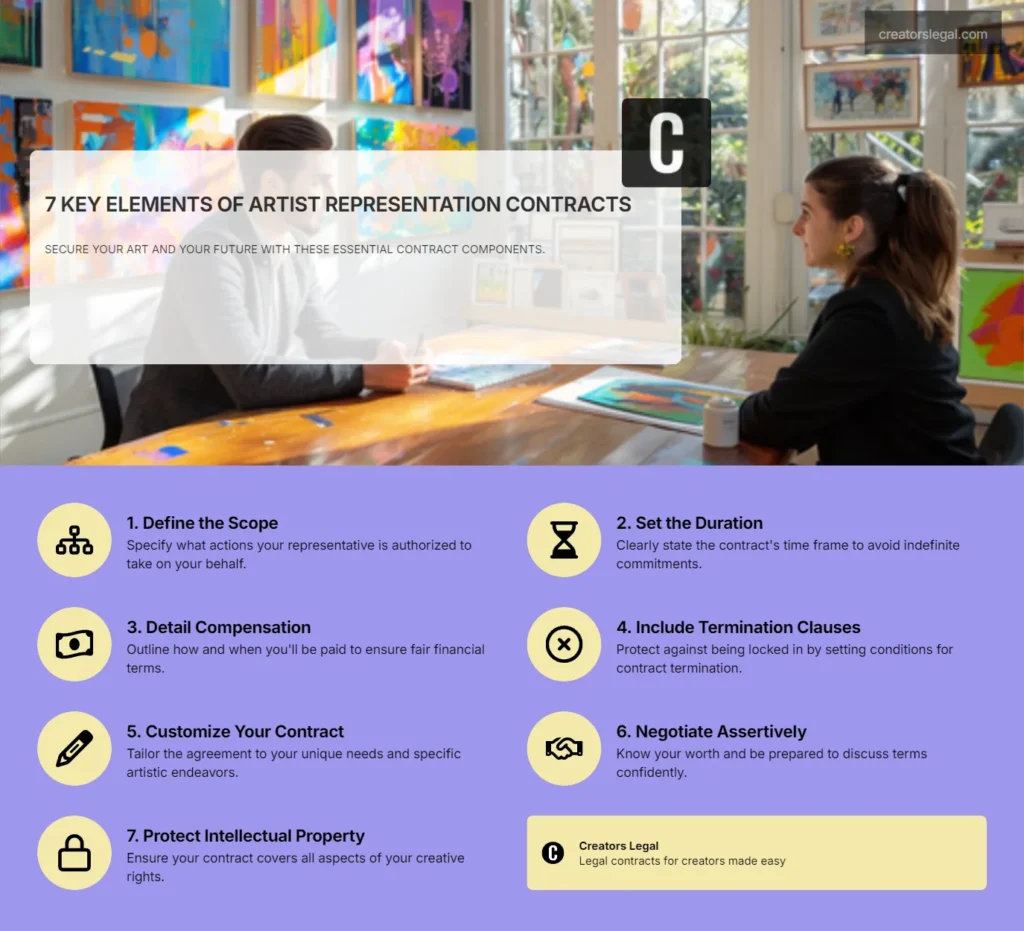Navigating the world of arts can be as complex as the creations themselves. But, when it comes to protecting your work and interests, many things can change. Have you ever wondered what safeguards you have as an independent artist when working with galleries or agents? This guide dives into the essentials of artist representation contracts, a crucial tool for any independent artist looking to secure their professional and creative rights. We’ll explore how these contracts can serve as your first line of defense against common legal pitfalls. Besides, what you can do to ensure your work remains protected.
At Creators Legal, we understand that the legalities can often seem overwhelming. That’s why we’re here to simplify the process. As a result, we offer clear, straightforward advice and customizable contract templates. What elements are essential in a contract, and how can you negotiate terms that respect your value as an artist? Keep reading to find out how to empower yourself in these crucial negotiations.
Understanding the Basics of Artist Representation Contracts

Definition and purpose
Let’s dive in, the purpose of artist representation contracts. By definition, they are legally binding agreements that outline the relationship between an artist and a representative. That’s to say, an art gallery, an agent, or a manager.
These contracts are crucial for independent artists, formalizing the expectations and responsibilities of both parties. The primary purpose of these contracts is to protect the artist’s rights and interests. Therefore, it ensures they receive fair compensation and recognition for their work.
Key Components in artist representation contracts
A well-structured artist representation contract includes several key components:
- Scope of Representation: Clearly defines what the representative is authorized to do on behalf of the artist.
- Duration: Specifies the length of the contract, providing a timeline for the partnership.
- Compensation: Outlines about the artists’ payment, whether through commissions, flat fees, or other arrangements.
- Termination Clauses: Details the conditions under which either party can terminate the contract, which is crucial for protecting the artist from being locked into an unfavorable agreement.
Common Legal Pitfalls in Artist Representation Contracts
Without a solid contract, artists can face numerous legal pitfalls. Common issues include:
- Non-payment
- Misrepresentation of the artist’s work
- And unauthorized use of the artist’s creations
A well-drafted artist representation contracts help prevent these problems by providing clear terms and legal recourse in the event of a breach.
Become One of 8,000+ Innovators Transforming the Future your Business!
Subscribe and access over 300 editable and downloadable contracts
Drafting Your Contract with Creators Legal
Using Templates
Creators Legal offers a variety of customizable contract templates that serve as a starting point for drafting an agreement. These templates, such as music contracts, are designed to cover the general needs of artists and can be modified to suit specific situations.
Customization for Specific Needs
Every artist’s situation is unique, and thus, a one-size-fits-all approach may not be sufficient. Customizing your contract to address specific needs is crucial. It might include stipulations about digital reproduction rights, specific gallery or exhibition arrangements, or unique payment terms.
Legal Terms Simplified
Creators Legal simplifies complex legal terms by explaining them in plain language. This demystification is vital as it ensures artists fully understand the contract they are entering into, which promotes compliance and reduces the likelihood of disputes.
Strategic Considerations in Contract Negotiation

Negotiating Terms
Negotiating artist representation contracts can be daunting. Key tactics include:
- Preparing thoroughly by understanding your minimum requirements and desired outcomes.
- Being clear about non-negotiable terms.
- Willingness to walk away if a deal does not meet your essential needs.
Understanding Your Worth
Artists must understand and articulate their value clearly in contract negotiations. That’s to say, recognizing the uniqueness of their work, professional standing, and their following. An accurate assessment of worth ensures that the contract reflects the artist’s value.
Protecting Intellectual Property
A crucial element of the negotiation is ensuring comprehensive coverage of intellectual property rights. It includes rights to reproductions, copyright ownership, and control over the commercial use of the artwork.
Real-World Application: Contract Scenarios and Solutions
Preventive Measures
Proactive measures in artist representation contracts include:
- Regularly reviewing and updating contracts to reflect new laws or changes in the artist’s career.
- Seeking advice from legal professionals when drafting or revising contracts.
- Educating oneself on common contract terms and their implications.
By addressing these areas, artists can safeguard their work and ensure their contracts serve their best interests.
Wrapping Up: The Power of Artist Representation Contracts

Artist representation contracts are essential tools for protecting your creative expression. In addition, it ensures equitable treatment in the professional realm. These contracts set specific terms for compensation, responsibilities, and the duration of partnerships. Also, it offers vital protections against issues like non-payment and unauthorized use of your work.
With customizable templates from Creators Legal, you can adapt the agreements to meet your specific needs. In that way, you can protect both your artistic and financial rights.
The process of negotiating a contract is also a process of self-discovery. Recognizing your value as an artist and the distinct worth of your work is crucial in these discussions. With a well-negotiated contract, you secure your current interests. Also, it lays the groundwork for future opportunities.
Remember, a contract protects what you’ve created and honors the value of your creations and the legacy you are establishing. As you advance, let these agreements provide the stable foundation for your artistic career to flourish. As a result, your work is not only seen, but also respected.






